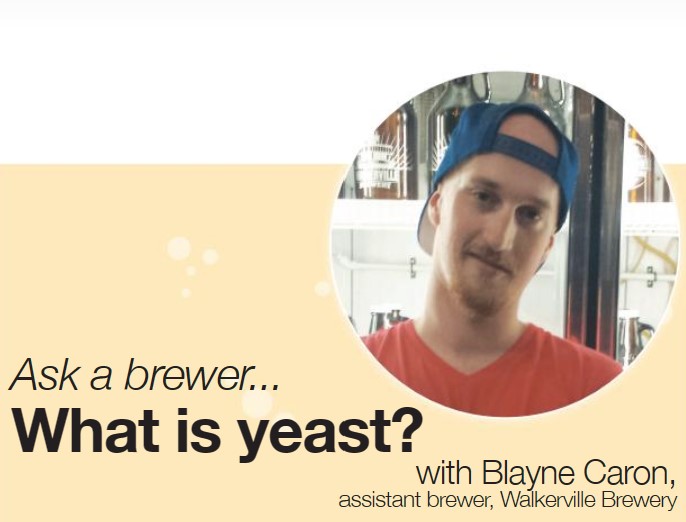The Urbanite – Jon Liedtke – Aug. 27, 2014
ASK A BREWER with Blayne Caron, assistant brewer, Walkerville Brewery
What is yeast?
Yeast is a microorganism, it’s a fungus, an eukaryote and it is the only microorganism that can produce alcohol. It’s a single celled organism, so it’s microscopic, but if you get a lot of it together, we pull it off of the tanks, and you get a sludge of it that you can see.
When does yeast get involved in the brewing process?
Yeast comes in at the very end after the wort is already made; we’ve turned all our starch. into sugar, we’ve cooled it down and put it into the tank. All we really do is make sugar water, the yeast is actually what makes beer.
The yeast… uses oxygen to get started and it begins eating the sugar and as soon as all the oxygen is consumed and it’s an anaerobic environment [a lack of oxygen], it starts producing CO2 and ethanol as a byproduct of eating the sugar, as well as other various things.
Different strains of yeast can produce secondary compounds that can change the flavour.
Are there different types of yeast?
There’s a lot of different strains [but] there’s two main types of yeast: lager and ale yeast. This is really the only thing that differentiates a lager from an ale, everything else is a subcategory of one of those two things and they’re slightly different species of yeast.
Lager yeast likes cooler conditions and it resides at the bottom of the tank when it is fermenting. Ale yeast likes slightly more warm temperatures, it usually ferments out a lot quicker, and it sits at the very top of the tank while it’s fermenting.
In the brewing industry, ale yeast and lager yeast, those are the two that you’ll typically use intentionally because they’ve been bred over hundreds of years to have the characteristics that we want, we know what to expect from them.
What is wild yeast?
Everywhere in the air there’s wild yeast, that’s how people make sourdough [bread]. If you ever see sun streaming in the windows and there are particles, that can be wild yeast.
Some breweries will make beers and inoculate with wild yeast by putting it outside and letting the yeast bind itself in. It’s actually called a coolship and it’s an open vat that you put outside overnight and you let wild yeast and other microorganisms, like lactobacillus bacteria, land in the beer and start to do their thing in there.
Sounds like bugs could get in that way?
You filter that out (laughs). Some breweries will do that, and it’s a more common practice in the craft brewing industry to experiment with wild yeast.
Do you?
No
Can yeast go bad?
What we do, because we reuse yeast, we harvest it from the tank and we can reuse it to ferment another beer.
Yeast has a lifespan, so it will die, but there will be some left over. Because the yeast falls out of solution, it collects along the bottom of the tank with leftover byproducts of the brew process, so the more you keep it, the more it becomes contaminated… as the generations go by, the yeast mutates and changes… and eventually it’ll stop working.

Jonathon Liedtke is the managing editor of The Urbanite, Windsor’s alternative newspaper. He is also a member of Windsor’s “Punk with Horns” band The Nefidovs, and as such, is committed to enhancing and sustaining the arts community.



Leave a Reply